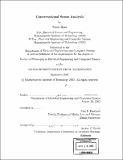Conversational scene analysis
Author(s)
Basu, Sumit
DownloadFull printable version (10.83Mb)
Other Contributors
Massachusetts Institute of Technology. Dept. of Electrical Engineering and Computer Science.
Advisor
Alex P. Pentland.
Terms of use
Metadata
Show full item recordAbstract
In this thesis, we develop computational tools for analyzing conversations based on nonverbal auditory cues. We develop a notion of conversations as being made up of a variety of scenes: in each scene, either one speaker is holding the floor or both are speaking at equal levels. Our goal is to find conversations, find the scenes within them, determine what is happening inside the scenes, and then use the scene structure to characterize entire conversations. We begin by developing a series of mid-level feature detectors, including a joint voicing and speech detection method that is extremely robust to noise and microphone distance. Leveraging the results of this powerful mechanism, we develop a probabilistic pitch tracking mechanism, methods for estimating speaking rate and energy, and means to segment the stream into multiple speakers, all in significant noise conditions. These features gives us the ability to sense the interactions and characterize the style of each speaker's behavior. We then turn to the domain of conversations. We first show how we can very accurately detect conversations from independent or dependent auditory streams with measures derived from our mid-level features. We then move to developing methods to accurately classify and segment a conversation into scenes. We also show preliminary results on characterizing the varying nature of the speakers' behavior during these regions. Finally, we design features to describe entire conversations from the scene structure, and show how we can describe and browse through conversation types in this way.
Description
Thesis (Ph. D.)--Massachusetts Institute of Technology, Dept. of Electrical Engineering and Computer Science, 2002. Includes bibliographical references (p. 106-109).
Date issued
2002Department
Massachusetts Institute of Technology. Department of Electrical Engineering and Computer SciencePublisher
Massachusetts Institute of Technology
Keywords
Electrical Engineering and Computer Science.